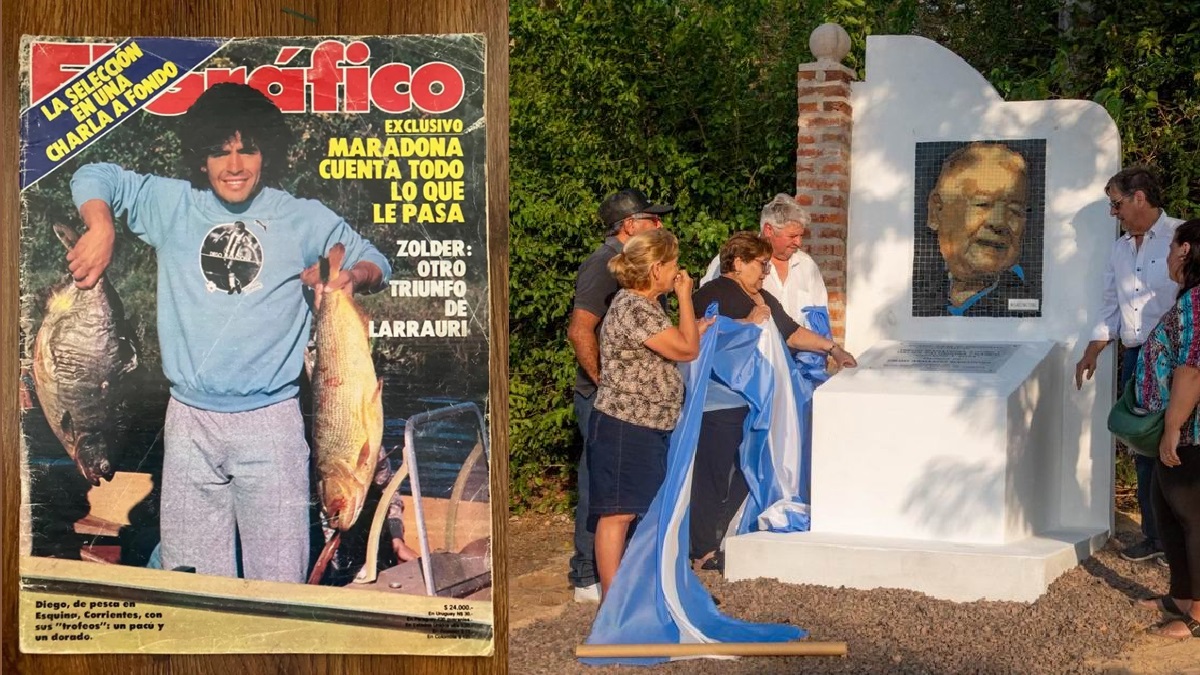
“I have Guaraní blood, yes: I am the son of Corrientes,” he responded with evident pride to the first person who asked him in front of a camera: the Spanish interviewer Jesús Quintero. “And what is that blood like?” Quintero asked. “For the people of Corrientes, according to my father’s friends—because he didn’t say it as much—Guarani blood has more courage; much more… fire,” he added. His face had lit up like no other moment in that unforgettable conversation.
It was around 1993 and Diego Armando Maradona was playing in the Sevilla after undergoing his first suspension for positive doping. For this reason, the Andalusian presenter took advantage of the unprecedented geographical proximity to the star to invite him to his cycle. the mouth of the wolffrom the channel Antenna 3. Quintero was from San Juan del Puerto, Huelva, about 80 kilometers from Seville, capital of the entire community of Andalusia. And the arrival of Maradona had not only revolutionized world football, but also that Spanish region in particular.
At that time Diego was finishing his first and only season in the strongest Andalusian team, as well as the last one he would play in Europe. Beyond the conflicts that their arrival went through (a difficult transaction with the Napoli in which the FIFA) and also his departure (months later he would go to Newell’s), Maradona completed between October 1992 and June 1993 a performance that was not inconsiderable: thirty official matches between the League and King’s Cup with seven goals, in addition to the friendlies that the club organized to get more income from his presence. Perhaps the most painful cost of all that intensity has been the resentment of his personal bond with Carlos Bilardo, coach of the Sevilla during that campaign. The relationship would never be the same since then.
In the interview with Quintero, Diego already sports short hair and is much skinnier and more athletic than when he had arrived in the city of Seville for the European autumn, several months ago. It was the beginning of his stylization on the way to United States World Cup (a year after his last game for the Andalusian team), where he would arrive in superlative physical condition, far better than the one he enjoyed for Italia ’90.
His good appearance on that outing the mouth of the wolf of 1993 is remarkable. “I just wanted to talk about football with the one who knew the most about it: Diego Armando Maradona. An artist”, Jesús Quintero had introduced him after a brief off-screen monologue, which also meant a lot of pampering towards a Diego who the mass media was beginning to pierce with moralizing speeches. The edited one lasts about half an hour and has practically no cuts: the talk flows between the smoke of Quintero’s cigarettes and the glass of water of a measured, loose and smiling Maradona.
Jesús Quintero had already done school with programs The crazy man on the hill y The green dogamong others. And Diego Maradona, in his case, too: he himself recognized already at that time, still active, that his peak had been in Mexico ’86.
The meeting of colossi ran through different topics that Maradona addressed without elaborating, although in a very precise manner, leaving in his wake dozens of titles that today would have very high resonance. After talking about Napoli and his stormy departure, taking a tour of Fidel Castro and Menem, poetizing about the ball (“I always want to have it close to me”) and deepening his uprising on behalf of the players against the FIFA (which started in Mexico ’86 with the protests over the schedules of matches in the sun and ended with a nurse taking him by the hand in United States ’94), Diego left a definition forever: “I rebel against being a slave.”
That was when Quintero, surprisingly, took him to an unexpected place: “Do you have Guaraní blood?” he asked. Maradona reacted with a childlike smile, his eyes slanted like a Corrientes, opening to a very intimate level of complicity, only accessible not so much by words, but by very determined gestures. If Diego declared himself a rebel, Jesús then wanted to go to the true origin of that rebellion that was also presumed to be class: there was genetic information in Maradona that positioned him as a social subject regardless of where he was, whether it was a village in Lomas de Zamora or a banquet in Dubai.

And if the commonplace was to take it to the metal boxes of Fiorito, Quintero went one step further: he delved into the prehistory of the Maradona family. In Esquina, the small town in Corrientes where Chitoro and Tota, their parents, were born and met. The Guaraní clay from which this Argentine with an Italian surname and born in the Buenos Aires suburbs came from, who, at that time, played in the Spanish soccer league under the observation, consumption and scrutiny of the entire planet. “Yes, I have Guarani blood,” he stressed.
Diego Armando was born on October 30, 1960, in Villa Fiorito, when the Maradona-Franco family had already moved to the settlement of Lomas de Zamora for five years. First came all Franco with Ana, one of the two daughters born in Corrientes, while Convenience store Maradona waited with Rita for the news from Esquina, a small town of less than ten thousand inhabitants at the time, 300 kilometers from the provincial capital. Fiorito was a suggestion from Aunt Sara, who had settled in the area during the first migratory movements from the Argentine interior to the Buenos Aires suburbs in the mid-20th century.
They lived in one hut, then in another, and finally in the house that the marathon liturgy canonized as a sacred site: Azamor between Mario Bravo and Antonio Filardi, ten blocks from Riachuelo and twenty from La Noria Bridge. There, in order, Elsa, María, Diego (the first boy), Raúl, Hugo and Claudia were born.

Shortly after arriving in the south of Greater Buenos Aires, Convenience store Maradona got a job in a bone grinder. A factory. Nothing to do with his job on the deep coast, where he worked as a boatman and passer-by on the Torelo, a canal that connects the Corriente River, on the coast of Esquina, with the powerful Paraná. “In small boats he took animals to the islands when the river went down and returned to look for them when the flood arrived, to take them back to the fields,” Maradona explained in I am Diegohis most circulated autobiography.
At that time, the first half of the 20th century, the Torelo was a short but sensitive stretch of the trade routes to the interior of the country, since it joined waters in a key area of Corrientes, near its limits with the provinces of Santa Fe and Entre. Rivers. According to Diego, this work allowed his father to access the mysteries of the leafy delta that surrounded Esquina: “He lived the river, he knew its secrets,” he acknowledged with admiration.

The Guaranític culture is rich in myths and legends linked to rivers and the habitats derived from them. Diego wrote his own in the waters of the Corriente and the Paraná, where he went countless times to get lost in inaccessible places, far from the siege. Together with Claudia, brothers or friends, but always with Convenience store driving the boat in that delta that I knew like few others. Esquina, due to its geographical condition, is also a fish spawning and breeding area, which makes it sought after by dorado fishermen, a species that appears in enormous quantities.
“I went to reconnect with my origins, with the Corriente River, with the Paraná Miní, through those places that my old man and his friends were capable of getting into and not getting lost,” he had said before the Spain World Cup 1982to which Diego was even questioned by some sectors, especially because of his physical condition. Something similar happened in 1989, when Conrado Ferlaino, president of the Napoliprevented him from transferring to Olympique de Marseille that Diego was looking for to leave an Italy that had already become stormy. “That time I went fishing for dorado and pacúes. And to think…”, he recorded.
Esquina was a place to which Diego Maradona resorted many times, and all of them with absolute discretion, something impossible anywhere else on the planet. Again the old man and his friends, the same ones who said that Guarani blood had something special, another courage, a fire. “There he had many of the things he liked, things that we shared: fishing, barbecue and soccer. One of my favorite outings is fishing,” said Diego.

That Guarani blood that Jesús Quinteros brought to his memory in that 1993 talk deepened a year and a half later, when Maradona directed Mandiyu of Corrientes. Although brief and uneven, it was his first experience as a coach, already going through his second suspension for positive doping after the World Cup in the United States: he started from the stands, won only one of the twelve games he coached and the technical duo he starred in with Carlos Fren It lasted just two months. In any case, he left a memorable 2-2 with the River of the Three Gallego who would win that Opening ’94 undefeated: Mandiyu it was quickly 2-0, and although the Millionaire tied before halftime, the Corrientes team had two clear opportunities in the agony of the game to win it.
From then on, and until the end of his life, Diego Maradona returned to Corrientes in different ways, either to fish, or to go to some of the various carnivals that take place in the province. And, as a good consumer of music that he was, he took chamamé in his heart. The Corrientes accordionist Diego Gutiérrez recalled that he was summoned in 2017 to play for Maradona in Paso de la Patria when, suddenly, the phone rang. It was Vladimir Putin direct from Moscow. “Tell him to call me on Monday, I’m hearing good chamamé in the land of all”, answered Diego Armando. “This guy is crazy: he calls me on a Sunday afternoon,” he argued, sitting on a stool, in front of those present.

One of the latest videos that went viral shows him listening to “Che, Taita”, by Ángel Piciochi, born in Sauce but living in Esquina. A sister had sent it to him on WhatsApp. Diego is on a bus through Mexico with the clothes of the Golden from Sinaloa, but his head travels through time and space with that Corrientes chamamé.
“It seems incredible how Argentina is stumbling, stumbling… and in the end, there is always that mixture of Guaraní, Tano and Galician that gives a special caste, right?”, analyzed Jesús Quintero in 1993, without knowing the use that thirty Years later the term “caste” would be given in these parts. “It’s true. We have a little bit of everything. And that makes the mix explosive: they can no longer easily defeat us,” Diego concluded.

Source: www.laizquierdadiario.com

